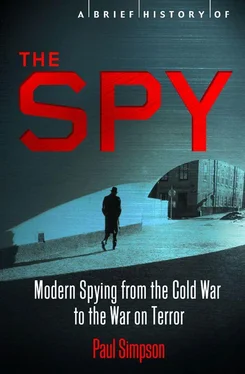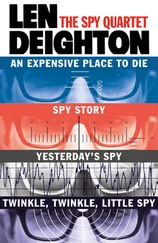Paul Simpson - A Brief History of the Spy
Здесь есть возможность читать онлайн «Paul Simpson - A Brief History of the Spy» весь текст электронной книги совершенно бесплатно (целиком полную версию без сокращений). В некоторых случаях можно слушать аудио, скачать через торрент в формате fb2 и присутствует краткое содержание. Город: London, Год выпуска: 2013, ISBN: 2013, Издательство: Constable & Robinson, Жанр: Прочая документальная литература, на английском языке. Описание произведения, (предисловие) а так же отзывы посетителей доступны на портале библиотеки ЛибКат.
- Название:A Brief History of the Spy
- Автор:
- Издательство:Constable & Robinson
- Жанр:
- Год:2013
- Город:London
- ISBN:9781780338910
- Рейтинг книги:3 / 5. Голосов: 1
-
Избранное:Добавить в избранное
- Отзывы:
-
Ваша оценка:
- 60
- 1
- 2
- 3
- 4
- 5
A Brief History of the Spy: краткое содержание, описание и аннотация
Предлагаем к чтению аннотацию, описание, краткое содержание или предисловие (зависит от того, что написал сам автор книги «A Brief History of the Spy»). Если вы не нашли необходимую информацию о книге — напишите в комментариях, мы постараемся отыскать её.
A Brief History of the Spy — читать онлайн бесплатно полную книгу (весь текст) целиком
Ниже представлен текст книги, разбитый по страницам. Система сохранения места последней прочитанной страницы, позволяет с удобством читать онлайн бесплатно книгу «A Brief History of the Spy», без необходимости каждый раз заново искать на чём Вы остановились. Поставьте закладку, и сможете в любой момент перейти на страницу, на которой закончили чтение.
Интервал:
Закладка:
Tenet’s successor at the CIA was Porter Goss, who would be the last CIA chief to act as head of the intelligence community; one of the many clauses of the Intelligence Reform and Terrorism Prevention Act prevented a DNI from serving as head of the CIA or any other agency at the same time. The first DNI, appointed in 2005, was former US Ambassador to the UN and Iraq, John D. Negroponte; his successor in 2007 Admiral Michael McConnell also served for two years. Neither really was in a position to force through the changes that were needed within the intelligence community. By the end of November 2008, even the DNI’s own Inspector General noted that the office was not providing effective leadership, which was ‘undermining ODNI’s credibility and fuelling assertions that the ODNI is just another layer of bureaucracy’.
Goss probably didn’t expect to become DCI. A few months before Tenet’s surprise resignation, in his capacity as Chairman of the House Intelligence Committee, Goss wrote to the Agency saying:
After years of trying to convince, suggest, urge, entice, cajole, and pressure [the] CIA to make wide-reaching changes to the way it conducts its HUMINT mission [the] CIA continues down a road leading over a proverbial cliff. The damage to the HUMINT mission through its misallocation and redirection of resources, poor prioritization of objectives, micromanagement of field operations, and a continued political aversion to operational risk is, in the Committee’s judgment, significant and could likely be long-lasting.
This damaged his relationship with senior staff at the Agency, many of whom would resign during his tenure.
Goss was succeeded by former NSA head, and Deputy DNI, Michael Hayden, who served from 2006 to 2009. During that time, the Agency was actively involved in (still-classified) missions in Pakistan, assisting with the removal of al-Qaeda’s leadership. ‘We gave President Bush a list of people we were most mad at, in the tribal region of Pakistan, in July 2008,’ he said in 2010. ‘By the time I left office, more than a dozen of those people were dead… What the Agency did to dismantle the al-Qai’da leadership… I’m most proud of that.’ The CIA also helped with the identification of a nuclear reactor that was being built in Syria with North Korean assistance. Hayden was an advocate of confirming the intelligence publicly after the event — not earlier, since the Syrians ‘might do something stupid if they were publicly embarrassed’ — in order to ensure that people were aware of the Korean involvement during the discussions over nuclear proliferation.
British intelligence agencies were also actively involved with counter-terrorism operations after 9/11. As the bombings in London on 7 July 2005 (known as 7/7) which killed fifty-two people proved, they weren’t always as successful as they might have liked, but as the public portions of the trials of terrorist suspects who have been arrested show, MI5 and MI6 have been responsible for preventing further atrocities. Errors have of course occurred — such as the shooting of innocent Brazilian electrician Jean Charles de Menezes on 22 July 2005, in the aftermath of an attempted second wave of bombings the previous day.
The attempt by Richard Reid to blow up a transatlantic jet just before Christmas 2001 was an indication to the British agencies that this form of terrorism could be home-grown. Over the next decade, MI5’s budget and personnel were increased, and they were able to monitor a larger number of suspects. Operation Crevice led to the arrest of a terrorist cell in 2003 shortly before they began a campaign against nightclubs, shops and pubs using ammonium nitrate bombs — although unfortunately two men with whom they briefly had contact were not monitored. They went on to cause carnage in London on 7/7. Operation Rhyme, which took place in 2004, prevented Dhiren Barot from carrying out his planned attacks in London underground car parks. Operation Hat stopped the failed bombers of 21 July 2005 from trying again. Kazi Rahman was arrested trying to buy weapons in November 2005 after a police and MI5 sting operation — his name had been passed to MI5 by the FBI after they were able to turn al-Qaeda operative Mohamed Babar the previous year.
Operation Overt was aimed against Abdullah Ahmed Ali, who planned to rival the scale of the 9/11 attacks using suicide bombers inside multiple aircraft departing from Heathrow. He and his co-conspirators were arrested in August 2006, shortly before they became operational; the way they intended to explode the devices is the reason why security measures regarding liquids being taken on board aircraft were tightened up immensely that summer. The nine members of a plot to create havoc at Christmas 2010, with targets including the Stock Exchange, Big Ben, Westminster Abbey, the Palace of Westminster and the London Eye, were arrested four days before they planned to set off their first device. On 1 July 2012, a plot by al-Qaeda in the Arabian Peninsula to explode a bomb during the London Olympics was foiled; a few days later, a suspected al-Qaeda terrorist was arrested after visiting the Olympics site in East London five times in one day, in contravention of the control order he was under.
As Eliza Manningham-Buller pointed out in a TV documentary about the war on terror, there never is just one plot being investigated. At any one time, dozens are under investigation.
Probably the highest-profile intelligence operation of the past few years has been the hunt for, and eventual assassination of al-Qaeda’s leader Osama bin Laden. While Khalid Sheikh Mohammed (KSM) may have been in charge of the details of the 9/11 plot, it was bin Laden who was its instigator and mastermind, making him the ultimate target of all the American intelligence activities in the decade following the destruction of the Twin Towers in New York.
US Navy Seal Team Six entered the compound at Abbottabad, Pakistan, and carried out the mission that eliminated bin Laden in May 2011, but they weren’t alone — members of the US Army’s 160th Special Operations Aviation Regiment (Airborne) and the CIA were there beside them. Surprising as it may seem, even on the day that President Barack Obama gave the authorization for the mission to proceed, no one had ever captured a photograph of bin Laden at the compound or been able to get a recording of the mysterious male figure who occupied the building’s top two floors.
Billions of dollars were expended by the US during the first decade of the twenty-first century on electronic surveillance. But it was through information gained through old-fashioned means — interrogating prisoners — that bin Laden was finally tracked down. The key to finding him turned out to be his trusted courier, Abu Ahmed al-Kuwaiti, aka Ibrahim Saeed Ahmed. Numerous leads had been followed up since bin Laden disappeared from Tora Bora in 2002, following the American invasion. All had turned out to be dead ends. Many of the al-Qaeda hierarchy had been tracked down and eliminated, as the CIA struck with Predator and Reaper drones, but not bin Laden himself. Every aspect of the tapes that he issued was analysed, whether it was the shape of the rocks in the background or the birdsong briefly audible. Large rewards were offered for information, but bin Laden’s almost messianic position as the perceived saviour of true Islam meant that there were no takers.
Al-Kuwaiti’s name was one of those mentioned by Mohammed al-Qahtani, an al-Qaeda operative who was originally groomed as a twentieth hijacker for the 9/11 attacks. Captured by the Pakistanis in December 2001, he was interrogated at the American base at Guantanamo Bay in Cuba, where he admitted, after weeks of abuse, that KSM had introduced him to al-Kuwaiti, who had given him instructions in secret communications. When KSM himself was captured, he told his Pakistani interrogators that al-Kuwaiti had helped bin Laden to escape from Tora Bora, although he later told his American questioners that al-Kuwaiti was retired. This information was divulged after his extreme interrogations, and seems to have been a deliberate attempt to put the Americans off al-Kuwaiti’s scent; his act of defiance is often quoted by those opposed to the extreme methods as proof that such means do not always work.
Читать дальшеИнтервал:
Закладка:
Похожие книги на «A Brief History of the Spy»
Представляем Вашему вниманию похожие книги на «A Brief History of the Spy» списком для выбора. Мы отобрали схожую по названию и смыслу литературу в надежде предоставить читателям больше вариантов отыскать новые, интересные, ещё непрочитанные произведения.
Обсуждение, отзывы о книге «A Brief History of the Spy» и просто собственные мнения читателей. Оставьте ваши комментарии, напишите, что Вы думаете о произведении, его смысле или главных героях. Укажите что конкретно понравилось, а что нет, и почему Вы так считаете.












